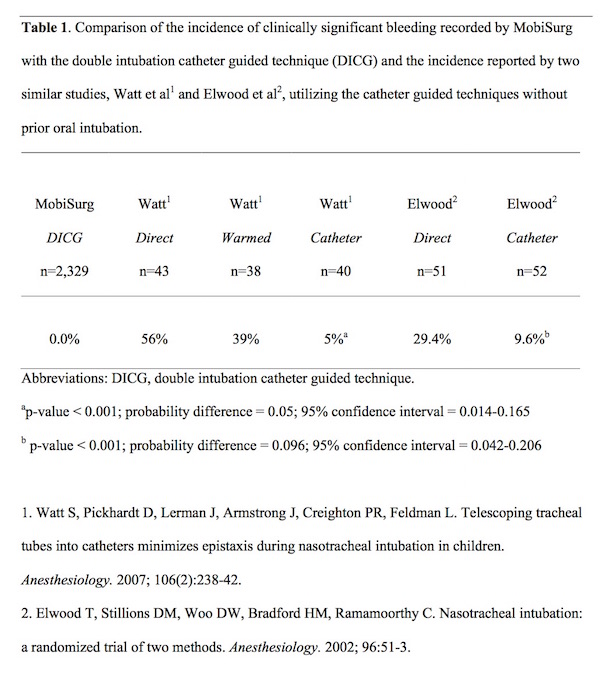OS1-130
Double Intubation Catheter Guided (DICG) Technique for Nasal Intubation May Reduce Severe Epistaxis and Major Complications in Children
Frey C, Choi N, Alikhani M, Meknat A, Alikhani S
MobiSurg, Inc., Laguna Hills, CA, USA
Introduction:
Nasal intubation is associated with complications, such as bleeding, damage to nasal tissue, and retropharyngeal tear. Techniques such as thermo-softening and catheter guidance have been suggested to decrease complications, however, there are no techniques to consistently eliminate severe complications. In this large-scale, retrospective study, pediatric patients were nasally intubated using a novel double intubation catheter guided (DICG) technique as a means of reducing severe complications.
Methods:
We studied 2,329 children under the age of twelve (4.4 + 2.2 yrs) using the DICG technique. Patients were first orally intubated, and one naris was pre-treated with Oxymetazoline. A 12 French red rubber catheter was introduced, and the tip was extracted through the mouth. The appropriate size endotracheal tube was inserted inside the wide end of the red rubber catheter and passed through the nose using the catheter as a guide. The nasal tube was introduced into the trachea as the oral tube was removed. A four-by-four gauze was inserted into the posterior pharynx, kept there for a minimum of 30 minutes, and inspected for bleeding. Bleeding was considered clinically significant if the gauze had over 40% of its surface area covered in blood or if the patient had bleeding requiring clinical intervention. Statistical analysis was performed using hypothesis testing to analyze the probability difference.
Results:
The incidence of clinically significant bleeding and other complications reported by our study was zero. Due to the small, private nature of our practice, we did not expose our patients to an increased risk of complications by utilizing other techniques. Given similarities between our study and other studies in the literature utilizing direct insertion, catheter guided techniques, and thermo-softening, we compared our data to those found in two similar studies (Table 1)
Discussion:
The DICG technique for nasal intubation allows immediate securing of the airway with oral intubation, prevents aspiration and allows ventilation. It permits ample time to prepare the naris and produces a virtually bloodless insertion of the nasal endotracheal tube. The lack of clinically significant bleeding and other complications in our study demonstrates that the DICG technique is a considerable improvement to existing techniques for nasal intubation. The down sides of the DICG technique are increased time to nasal intubation and the need for multiple intubations.
Conclusion:
The double intubation catheter guided (DICG) technique for nasal intubation eliminates the risk of severe complications for nasal intubation in children. It should be routinely taught in training programs as a preferred technique for nasal intubation.
1. Alikhani, S. The Double Intuation Catheter Gided (DICG) Technique for Nasal Intubation: Is a bloodless field possible, every time? (Submitted for publication) Society of Pediatric Anesthesia 2017
Top












